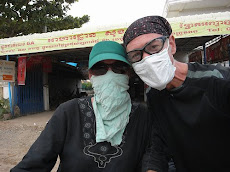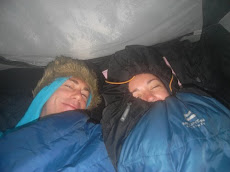
The weather was turning cooler by the day and the hot bowl of noodle soup with a plate of steaming dumplings with chili sauce for breakfast never tasted so good. On our way east out of Nanchang we came upon a young chinese cycle tourist - without access to the latest gear he was piled high with bags, appeared to be using a cardboard shoe box as a front pannier and was carrying an enormous bike pump. He was dressed in camouflage clothes and travelling at the speed of a tortoise - disappointingly he spoke no english and we could only determine that he was on his way to Beijing, the fact that he seemed to be lost and going in the wrong direction only made us like him even more. A true pioneer who brightened a dull grey day.

In the middle of nowhere we came across hundreds of restaurants lining the roadside selling crabs and we stopped for lunch. I was amazed to see that the chinese method for eating them was learnt from sea otters - they were just chomping them up, shell and all and then spitting out the crunchy bits. This also helped explain why makeshift dentists with a deckchair and rows of false teeth can be found in China's parks.
Yugan was just another dull chinese town but I enjoyed a stroll in the early morning sunlight, past rows of steaming dumpling trays, watching the chaos of handcarts, motorbike taxis and cycle rickshaws and in the still waters of the town's lake the floating corpse of a pig.

Further east we found some quieter roads with less noise and dust and some smooth tarmac and it was cozy in the tent at night. The rice crop was ready and in the golden fields gangs of peasants were cutting, threshing and drying, while flocks of swallows passed overhead, migrating south for winter. Cycling towards Wuyuan we were amazed to come across an open air theatre in the middle of the countryside with a performance of Peking Opera in full flow. We stood with our bikes and watched alongside the villagers taking a break from the fields but we could only stand the shrill, high pitched wailing for so long and continued east.
 After riding through China for a month without sight of another westener we finally reached another tourist area. For reasons of history, across China there are pockets of villages spared the worst ravages of the Cultutal Revolution, communist architecture and modern development that, with some "renovation" (ie re-creation) have been turned into tourist villages. Bus loads of chinese tour groups pay whopping entrance fees to be led around the narrow streets by microphone wielding, flag bearing tour guides and get a glimpse of pre-revolution China. And so it is in this nation of two countries that wealthy chinese from the cities turn up to take photos of rural chinese washing their clothes in the picturesque village streams. Despite the daytime circus, in the early morning and late afternoon sunlight and in the surrounding fields and valleys Little Likeng and its friendly villagers did have a wonderful charm now lost from most of China.
After riding through China for a month without sight of another westener we finally reached another tourist area. For reasons of history, across China there are pockets of villages spared the worst ravages of the Cultutal Revolution, communist architecture and modern development that, with some "renovation" (ie re-creation) have been turned into tourist villages. Bus loads of chinese tour groups pay whopping entrance fees to be led around the narrow streets by microphone wielding, flag bearing tour guides and get a glimpse of pre-revolution China. And so it is in this nation of two countries that wealthy chinese from the cities turn up to take photos of rural chinese washing their clothes in the picturesque village streams. Despite the daytime circus, in the early morning and late afternoon sunlight and in the surrounding fields and valleys Little Likeng and its friendly villagers did have a wonderful charm now lost from most of China.
We cycled north along river valleys, past neat rows of clipped tea bushes and ancient camphor trees. Praying Mantis were undergoing some kind of mass migration and it was impossible not to squash some of them as they bumbled across the roads. In the late afternoon we began passing through a series of old Qing and Ming era villages like Little Likeng without the tourists and the renovation. White buildings with tiled roofs and horsehead gables, flagstone paths and arched stone bridges over small streams, woodsmoke hanging in the valleys. Tarmac gave way to stony track as we made our way up the valley to a ridge of mountains. We camped next to a clear stream full of plastic bags and ate our pot noodle in the rain.
It was sunny next morning and we bounced along the track past more picturesque villages and as we started to make our ascent of the mountain tarmac made a mysterious but welcome return. It took a couple of hours to reach the pass and we barely saw another vehicle. Over the top we crossed into the province of Anhui and the tarmac for the descent was fresh and smooth and the scenery sublime. It was easily the most enjoyable cycling we did in China. We stopped for lunch in a village and ate in an old wooden building where we were served a pot of the best green tea I've ever tasted. The locals were very friendly, a bit tipsy and slightly confused as to our purpose in their village and before we knew it I was having a telephone conversation with an equally confused policewoman. We continued down out of the mountains and made it to the village at the foot of Qiyan mountain where we took a room with a view of the old stone bridge across the river and the hills behind. Suddenly China didn't seem so bad.
T was excited to take her first ever cable car ride to the top of the mountain and on a warm, sunny autumn day we enjoyed the mountain paths, Taoist cave temples and amazing views so much that we nearly missed the last cable car down.
We cycled east through Huangshan city where we stopped at a gaming cafe and booked a ferry to Japan, which was exciting and a relief as our visas were fast running out. North of the city we were back on busy, noisy, dusty roads with mile after mile of factories and sprawl. The evenings were drawing in and in the fading light we managed to find a spot for the tent amongst the neatest, well tended fields in the world. The friendly villagers were out at dawn and after the surprise of finding us in their field insisted on picking half a tonne of sweet potatoes to load on my bike.
It was a lovely sunny day as we made our way up a valley into some mountains. We passed a lady selling marrow fritters that were so tasty we ate thirds, causing much mirth amongst the locals. The road up to the pass was quiet with rural scenes of mulberry bushes, bee farmers and almost the entire population employed cracking pecan nuts by hand. Over the pass we entered Zhejiang Province and descended along a broadening river valley camping the night under a starry sky on a wooded ridge that would be our last night under canvas for a while.

Although mainly downhill it was a tiring 75 mile ride along busy, noisy roads and through the sprawl and industry to the city of Hanhzhou. We had reached the more prosperous, industrialised eastern region of China. Only students and old people still ride bicycles, everyone who can afford it has an electric scooter bike. In the cities there are millions of them whizzing around causing chaos. In order to cope the authorities in places like Hangzhou and Shanghai have created enlarged 2-wheeler lanes and banned them from the rest of the road. In the parlance of ancient China these would be called "the lanes of a thousand near misses and minor accidents". As we sped into Hangzhou rush hour riding the madness of these lanes with thousands of scooters was electrifying.

Hangzhou is famous for its beautiful West Lake, surrounded by pagodas, temples, landscaped gardens, tea plantations and meandering walks. It is mobbed by chinese tourists and couples in wedding outfits with an entourage of photographers, make up artists and hair adjusters. Unfortunately our visit coincided with the annual fireworks display and the lake was cordoned off by thousands of grumpy police paid for by the people of China so that the People's Republic could charge the people of the republic an extortionate amount of money to watch them alongside the local dignitaries. Nothing is free in the land of the people. We had to stay an extra day so that we could enjoy the lake.

From Hangzhou we rode 60 miles to the north-east without a break in the smog or factories. It was all capitalist China cliches - black fetid rivers, sweatshops with names like "magic knitting" and billboards advertising firms that were "hand-in-hand with fashion and side-by-side with trend." From the 11th floor of the Motel 360 we had a birds eye view of Jiaxing city. China is not a country for "point-and-hope" when it comes to ordering food and my tired lapse into laziness resulted in offal soup for dinner.

It was another 60 miles of industry to Suzhou. Some of the chimney stacks had been painted blue with clouds to blend into the sky but smog grey would've been a better colour. Although surrounded by factories the centre of the city was a pleasant place dotted with old merchants houses, canals and its famous gardens dating back to the 14th century. There were boutique style shops and cafes and excellent food.

Making our way out of the city under the concrete flyovers we discovered that the road to Shanghai was closed and a diversion in place. Undeterred we assumed it was some minor works that we could negotiate on the bikes and carried on. After a couple of miles it became apparent that the road was closed because a raised 6 lane expressway was being built in its place. Not wanting to backtrack we asked some men in hard-hats the way to Shanghai, obviously being conscious of Health & Safety regulations they directed us to continue through a major construction site, which at one point involved squeezing under the hydraulic legs of a crane while it was manoeuvring a massive slab of concrete into place. Construction workers laughed in amazement as we negotiated our way through the site. Eventually we emerged unscathed onto the "old" road and had 6 lanes all to ourselves for several miles, which was a slightly surreal experience, like a post oil vision of the future.

We rode another 60 miles of non-stop factories to central Shanghai, the sprawling metropolis of 20 million people. We lodged at a backpackers hostel, grabbed some beers and wandered down to the famous waterfront Bund to see the spectacular nightime skyline and celebrate cycling 11,000 miles across the vastness of the Eurasian continent. It seemed only fitting to find that it was a boarded up construction site.












No comments:
Post a Comment